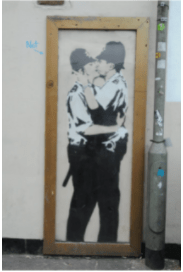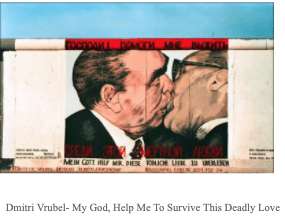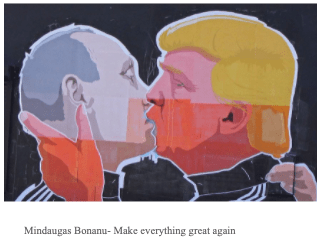Graffiti: What is the Value( changing later)
Willa Field
“Usually unauthorized writing or drawing on a public surface”—how ‘graffiti’ as defined by The Merriam-Webster Dictionary. Graffiti has long since been demonized and its artists penalized, but the newly branded street art is making its mark on the world. There is a long-standing debate on the value of graffiti; some see it as simple vandalism, while others see it as a true masterpiece. I would argue that the social impact of graffiti is equal to and, in some cases, greater than that of more traditional fine art. Two artists and their work have helped me draw this conclusion, as their work has become notorious for its social and political implications and impact.
 The anonymous Banksy gained fame by their use of graffiti art to convey their ideology, their art generating many conversations and interpretations. A famous one of theirs called “Kissing Coopers” was sprayed on the wall of Prince Albert pub in Brighton, England in 2004 and restored in 2011. The stencil image depicts two male officers in uniform locked in a heated embrace. There are many interpretations, often stemming from a person’s own beliefs. Some believe the intention was to show police in a more humanizing light. Some see it as a mockery of law enforcement, and some see it as the artist advocating for LGBTQIA+ rights and acceptance. We’ll never know Banksy’s intentions, and at the end of the day, it’s not about theirs, but what other people make of it. Using the streets as a canvas, Banksy managed to disrupt how we view the world, make us question the systemic norms, and look at the people in power through a more critical lens. They have managed to impress upon the public the legitimacy of graffiti as an art form.
The anonymous Banksy gained fame by their use of graffiti art to convey their ideology, their art generating many conversations and interpretations. A famous one of theirs called “Kissing Coopers” was sprayed on the wall of Prince Albert pub in Brighton, England in 2004 and restored in 2011. The stencil image depicts two male officers in uniform locked in a heated embrace. There are many interpretations, often stemming from a person’s own beliefs. Some believe the intention was to show police in a more humanizing light. Some see it as a mockery of law enforcement, and some see it as the artist advocating for LGBTQIA+ rights and acceptance. We’ll never know Banksy’s intentions, and at the end of the day, it’s not about theirs, but what other people make of it. Using the streets as a canvas, Banksy managed to disrupt how we view the world, make us question the systemic norms, and look at the people in power through a more critical lens. They have managed to impress upon the public the legitimacy of graffiti as an art form.
Before Banksy was dominating headlines, another person and their graffiti were renowned: Dmitri Vrubel and his work “My God, Help Me To Survive This Deadly Love” (1990, restored in 2009).
Survive This Deadly Love” (1990, restored in 2009).
After being shown a photo of Leonid Brezhnev and Erich Honecker—taken by Régis Bossu—he felt compelled to recreate it, catching the eye of fellow artists. Invited to paint on the east side of the Berlin Wall, he subsequently created a world-renowned symbol for the Berlin Wall, and by extension, the Cold War and the former Soviet Bloc. As a self-proclaimed “Homo Sovieticus”, he continued a private life, seeking neither fame nor capital gain. There were countless images of his work printed onto souvenirs, sold all across the city, solidifying it in people’s minds as a symbolic representation of the wall. When someone washed the graffiti away, Germany made a public outcry at the erasure of their history, sparking the media to cover the act and artwork extensively. Yes, graffiti—what people deem as simple vandalism—became an integral record of history.
Like many things, over time, “My God, Help Me To Survive This Deadly Love” has a whole new interpretation. Leonid Brezhnev( secretary of the Communist Party and Chairman of the Presidium of the Supreme Soviet) and Erich Honecker (Chairman of State Council of East Germany) were engaging in the ‘Socialist fraternal Kiss’, which was the proper greeting between influential socialist leaders at the time. In the 21st century, people have assigned a new meaning to it: a sexual one. There have been many recreations of Vrubel’s art, swapping Brezhnev and Honecker with more  current politicians. These interpretations are created with the new intention of portraying them in a more amorous relationship. They symbolize anything from a symbol for homosexuality to a thoughtless mockery that invites homophobia. The most famous of them were the ones depicting Donald Trump and Vladimir Putin. They sparked copious amounts of media coverage, opinions, controversies, public discussions, Twitter debates, etc. One creator said they had no sexual innuendos behind it but was happy with people seeing it as a way to show that it was okay for men to kiss men. Others simply mock Trump and Putin, but all of them have unintentionally incited homophobia. “These images reinforce a harmful narrative that being LGBT is inferior or something to be ridiculed; Chris Godfrey Tweeted, “Being gay isn’t a punchline. Find a new joke please.” as a response. Many people agree that mocking political figures by portraying them as gay is damaging. “This isn’t political satire, it’s just old-fashioned homophobia.” How “My God, Help Me To Survive This Deadly Love” and its re-creations were viewed changed, there is no denying the impact it’s made in the 31-year-old timeline.
current politicians. These interpretations are created with the new intention of portraying them in a more amorous relationship. They symbolize anything from a symbol for homosexuality to a thoughtless mockery that invites homophobia. The most famous of them were the ones depicting Donald Trump and Vladimir Putin. They sparked copious amounts of media coverage, opinions, controversies, public discussions, Twitter debates, etc. One creator said they had no sexual innuendos behind it but was happy with people seeing it as a way to show that it was okay for men to kiss men. Others simply mock Trump and Putin, but all of them have unintentionally incited homophobia. “These images reinforce a harmful narrative that being LGBT is inferior or something to be ridiculed; Chris Godfrey Tweeted, “Being gay isn’t a punchline. Find a new joke please.” as a response. Many people agree that mocking political figures by portraying them as gay is damaging. “This isn’t political satire, it’s just old-fashioned homophobia.” How “My God, Help Me To Survive This Deadly Love” and its re-creations were viewed changed, there is no denying the impact it’s made in the 31-year-old timeline.
Graffiti, aerosol art, street art, vandalism, Banksy, and Vrubel have revolutionized how the public sees it. No longer is it only seen as a nuisance in public spaces, but a legitimate work of art. Street art is a way to share insights, struggles, social and political issues, feelings, opinions, and personal style and artistic ability like any other art. There is no more enormous gallery than the city; there is no larger audience, there is no greater variety of viewers, there is no better place to create a broad social and political impact through art. By no means do I value graffiti over other types of art, but I believe it is undervalued and its artists severely unappreciated; it deserves a place next to the others.
Works Cited
Borzenko, Andrey. “Brotherly Love: 25 Years on, the Artist behind the Iconic Berlin Wall Mural Tells His Story.” The Calvert Journal, 11 Nov. 2014, https://www.calvertjournal.com/articles/show/3356/Dmitri-Vrubel-Berlin-Wall-Brezhnev-Honecker-Kiss
elizacourt1. “The Kissing Police Officers.” Design DiALOGUE, WordPress, 13 Apr. 2018, https://wordpress57027.wordpress.com/2018/04/13/the-kissing-police-officers/
Naylor, Alide. “The Strange Roots of the Homophobic Trump-Putin Kissing Meme.” Frieze, 8 Aug. 2018,https://www.frieze.com/article/strange-roots-homophobic-trump-putin-kissing-meme
Unknown. “’Homophobic’ Jokes about Trump and Putin Criticised by LGBT Campaigners.” BBC News, 17 July 2018, https://www.bbc.com/news/newsbeat-44859358
Unknown. “The Socialist Fraternal Kiss between Leonid Brezhnev and Erich Honecker, 1979.” Rare Historical Photos, 25 Mar. 2014, https://rarehistoricalphotos.com/socialist-fraternal-kiss-leonid-brezhnev-erich-honecker-1979/